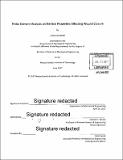Finite Element Analysis on the skin properties affecting wound closure
Author(s)
De Maillé, Austin (Austin C.)
DownloadFull printable version (6.192Mb)
Other Contributors
Massachusetts Institute of Technology. Department of Mechanical Engineering.
Advisor
loannis V. Yannas.
Terms of use
Metadata
Show full item recordAbstract
This thesis presents a Finite Element Analysis investigation on the properties of skin that affect skin wound closure and scar formation. It begins with an in depth literature review of mammalian studies and computer simulations of skin wounds, providing a better understanding of the mechanics of skin during wound healing. Details are then provided into the construction, simulation, and data processing of a finite element model in which wound shape, wound contraction forces, and subcutaneous tissue resistance are all varied. Two major conclusions can be drawn from these simulations. (1) When comparing rectangular, square, and circular wounds of the same initial wound size, rectangular wounds close fastest and circle wounds close slowest. (2) Subcutaneous tissue appears to be physically connected to the underlying dermis. Increased resistance/stiffness forces by subcutaneous tissue lead to less tissue contraction, however the relationship between skin deformation and subcutaneous resistance has not been determined. It appears that as skin displacement increases, subcutaneous tissue stiffness exponentially increases. Additional simulations must be completed to confirm this theory. Other factors affecting skin contraction, including skin thickness and Langer lines, have yet to be tested and should be pursued in future studies.
Description
Thesis: S.B., Massachusetts Institute of Technology, Department of Mechanical Engineering, 2017. Cataloged from PDF version of thesis. Includes bibliographical references (pages 32-33).
Date issued
2017Department
Massachusetts Institute of Technology. Department of Mechanical EngineeringPublisher
Massachusetts Institute of Technology
Keywords
Mechanical Engineering.